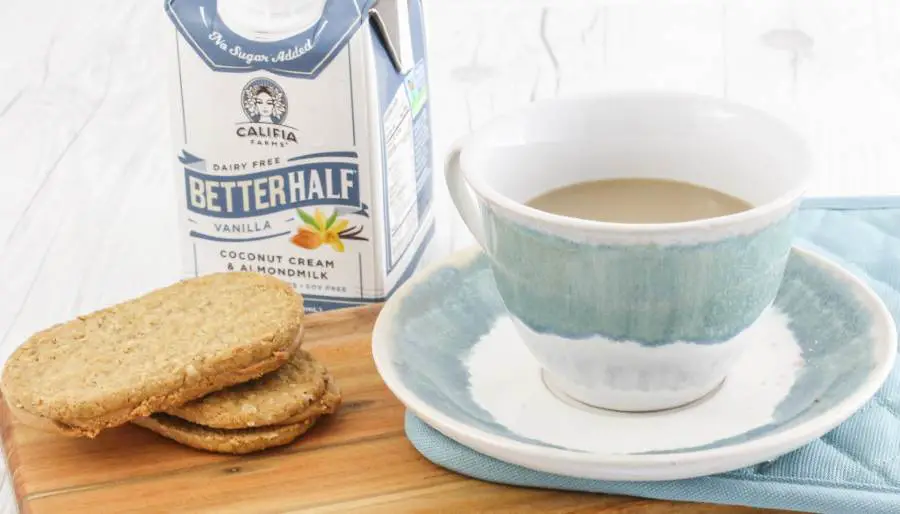
Some time ago, I had a big problem with creamers: every attempt at using creamer in my coffee would end up in chunks of creamer floating in my coffee. I was so frustrated as I did not know what was causing it.
None of my friends had a solution for it. So, I decided to scour the Web and try the solutions that I found.
Why is my coffee creamer chunky?
If your coffee creamer is chunky, it could mean one of the following: the creamer has gone bad, or the coffee is too acidic, too hot, or too cold. Also, mixing sugar and creamer first before adding coffee can cause creamer to form lumps of white particles in the coffee.
If your coffee creamer is thicker than normal, it does not always mean that you should discard it. Unless you establish that the creamer has spoiled, there should be no cause for alarm although the clumpiness can put you off.
Does your Chobani creamer chunk? I once discarded my favorite Chobani creamer because it was too thick but when it happened again with a new packet, I wasn’t going to dump it as it had no odd odor or taste.
I found that with a bit of stirring when adding the unusually thick Chobani creamer to my coffee, the creamer was not chunking. Voila!
4 Reasons Why Your Coffee Creamer is Chunky.
Let’s look at the reasons why coffee creamer curdles in coffee and how to prevent it.
1. High Acidity in Coffee Can Cause Creamer to Curdle
Coffee that has a high acidity can cause creamer to turn sour and curdle. It is the same process that happens when you add some fresh lemon juice into a cup of milk.
The acidity causes casein (milk proteins) to collect together and coagulate leading to creamer particles that float around.
If coffee creamer is curdling in your coffee due to high acidity, try the following tips:
1. Add a Pinch of Salt to the Coffee
Salt neutralizes coffee’s acidity and stops your favorite creamer from chunking. A pinch of salt will do for a cup of coffee.
2. Add a Tiny Pinch of Baking Soda
Sounds weird right? Well, baking soda is used in wine especially champagnes to reduce acidity. A tiny pinch of baking soda in your coffee will also neutralize the acidity. When you add creamer to the coffee it will not chunk.
Too good to be true? I had to try it and it works like a charm!
Be sure to add only a tiny amount of baking soda as a bit too much and the coffee will have a detestable soda taste.
3. Use Dark Roasts
Some of the chlorogenic acids in coffee break down when coffee beans are roasted longer at higher temperatures. Therefore, darker roasts are usually less acidic than lighter roasts.
4. Low Acid Coffee from Low Elevation Areas
High acid coffee usually grows in the highlands. Coffee from Africa is more acidic than coffee from low elevations such as Sumatra.
5. Add Eggshells to Ground Coffee
Adding eggshells to the ground coffee before brewing alkalizes the coffee and yields a smoother cup of Joe. Use about one egg for 4 cups of coffee.
Simply break the egg and clean the shells with warm water. Crash the shells in your hand and mix them with the ground coffee. Brew the coffee as normal.
Avoid crushing the shells too fine as they may end up in the brewed coffee.
The shells are alkaline so they reduce the level of acidity in coffee. Your creamer will mix properly without chunking.
2. How Coffee Temperature Causes a Chunky Creamer
Sudden changes in creamer temperature cause the milk proteins in coffee creamer to clump together. For example, coffee that is too hot is likely to curdle chilled coffee creamer.
To minimize this, let your coffee sit for a few seconds for the temperature to drop before adding the creamer. Alternatively, warm the coffee creamer before adding it to the coffee. Read our post on how to heat up the creamer.
Similarly, adding ice cubes to liquid creamer causes the milk proteins to coagulate. You are better off adding coffee and ice together and adding creamer a minute or so later.
When mixing liquid creamer and iced coffee, stir properly to break down any lumps. Powdered coffee creamer is unsuitable for cold coffee because it will not dissolve.
You are better off dissolving powdered creamer in hot coffee or hot water first and then adding ice instead of adding it to already cold coffee.
3. Chunky Creamy Can be a Sign of Spoiled Creamer
Sourness in creamer can be a precursor to spoiling. As creamer loses freshness, lactic acid builds up causing the creamer to curdle.
Use a spoon to taste and smell the creamer before deciding on whether it has gone bad. Look for off-tastes and funky odors
If the creamer smells and tastes normal, then it’s safe to drink although its freshness must have deteriorated.
Read our post about how long creamer lasts.
4. How Sugar Causes Creamer to Chunk in Coffee
A study by the USDA found that when you mix sugar and creamer first before adding hot coffee, sugar absorbs the water molecules in the creamer and causes casein to precipitate when you add hot coffee.
The study suggests that it’s desirable to mix hot coffee and sugar first and then add creamer to minimize curdling. Alternatively, use sugar syrup instead of solid sugar.
Here is a summary of how to prevent coffee creamer from curdling in coffee
- Ensure that coffee creamer is stored properly and is not spoilt. Read about the proper way to store coffee creamer.
- Avoid rapidly changing the temperature of creamer when adding it to your coffee
- Use low-acid coffee with creamer
- Mix sugar and coffee first before adding creamer
Chunky Creamer Wrap Up
A chunky coffee creamer need not be a sign of spoilt creamer. Inspect the taste and smell of the creamer for any off-tastes and smells before checking on the factors that cause the creamer to curdle.
Some of the reasons why creamer chunks in coffee are acidic coffee, coffee temperature, and adding sugar to creamer before adding coffee.
Adding eggshells, salt or baking soda is a great way to neutralize the acidity of coffee and stop creamer from separating and clumping. You can also go for low-acid coffee such as dark roasts and coffee from low elevated areas.
Warming creamer before adding it to hot coffee will prevent it from clumping. Similarly, use chilled creamer with cold coffee and stir properly.
The water that you use for your brew can also make the coffee more acidic. Filtered water or bottled water is your best bet when making coffee.
If you have changed the coffee beans and tried all our recommended ways of preventing creamer from chunking without success, check the acidity of your water.
FAQs About Why Your Coffee Creamer is Chunky
Why is my Coffee Creamer not Dissolving?
Powdered coffee creamer is unlikely to dissolve in cold coffee. You are better off adding powdered creamer to hot coffee or first dissolve the creamer in a small amount of hot coffee or water and then add it to the cold coffee.
When making instant iced coffee with powdered creamer, mix the coffee granules with powdered creamer and add warm water to dissolve the mixture. Then, add ice and cold water to fill your cup.
White particles that float in your coffee when you add liquid creamer can indicate curdling. Earlier in this article, we covered the possible reasons why your coffee creamer is chunky and how to prevent it.
